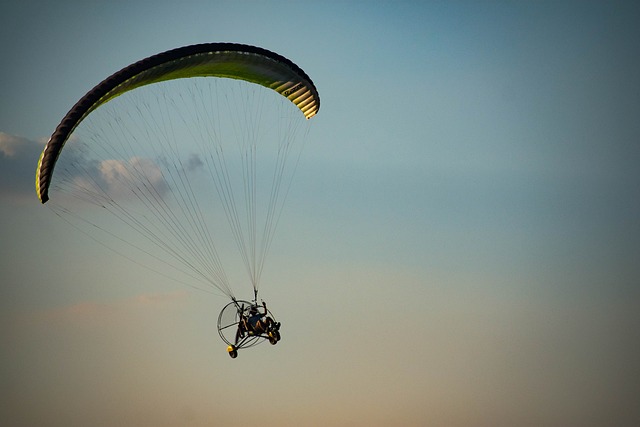Electric paramotors are a new type of aircraft that has been gaining popularity in recent years. These aircraft are powered by electric motors instead of gas engines, providing a quieter and more environmentally friendly alternative. However, one of the major concerns for electric paramotor pilots is the range of the aircraft.
In this article, I will explore the importance of range in electric paramotors and the factors that affect it. I will also discuss typical ranges for electric paramotors, tips for maximizing range, and future developments in battery technology that could extend the electric paramotor range.
The Importance of Range in Electric Paramotors
The range is a crucial factor for any aircraft, and electric paramotors are no exception. The range of an electric paramotor refers to the maximum distance that can be traveled on a single battery charge. In other words, it is the amount of time that the aircraft can stay in the air before needing to land and recharge.
For electric paramotor pilots, range is especially important because it determines the types of flights that can be undertaken. A longer range allows for more extensive and adventurous flights, whereas a shorter range limits the distance that can be covered and the amount of time that can be spent in the air.
Additionally, range can affect safety. If an electric paramotor runs out of battery power mid-flight, it can be dangerous for the pilot and any passengers on board. Therefore, understanding the range of an electric paramotor is crucial for planning safe and successful flights.
Factors such as battery capacity, weight, and weather conditions can all affect the range of an electric paramotor. Understanding these factors and their impact on range is important for optimizing flights and ensuring that pilots can safely reach their destinations.
Factors Affecting the Range
Several factors can affect the range of an electric paramotor. Understanding these factors can help pilots optimize their flights and extend their range. Some of the main factors that affect electric paramotor range include:
- Battery capacity and type: The capacity and type of battery used in an electric paramotor can have a significant impact on range. Larger batteries with higher capacities can provide longer flights, but they are also heavier and may impact the overall weight of the aircraft. The type of battery used can also affect range, with some battery chemistries providing better performance than others.
- Weight of the paramotor: The weight of the aircraft, including the weight of the pilot and any passengers or cargo, can also affect range. Heavier aircraft require more energy to stay in the air, which can reduce the overall range.
- Wind speed and direction: Wind speed and direction can affect the speed and efficiency of an electric paramotor. Flying into a headwind can reduce speed and increase the amount of power required to stay in the air, reducing range. Conversely, flying with a tailwind can increase speed and improve range.
- Altitude: Altitude can also affect the range of an electric paramotor. Higher altitudes can reduce air density, which can make it more difficult for the aircraft to stay in the air. This can reduce range, as the aircraft requires more power to maintain altitude.
- Ambient temperature: Temperature can also affect the performance of an electric paramotor. Cold temperatures can reduce battery performance, while hot temperatures can cause the battery to degrade more quickly.
Understanding these factors and how they affect range is crucial for electric paramotor pilots. Pilots can optimize their flights by taking these factors into account and making adjustments as necessary to extend their range and safely reach their destinations.
Typical Electric Paramotor Ranges
The range of an electric paramotor can vary widely depending on several factors, including battery capacity, weight, wind conditions, altitude, and temperature. However, some general estimates of typical electric paramotor ranges can be provided.
On average, electric paramotors can provide a range of around 30-60 minutes of flight time on a single battery charge. This equates to a range of around 10-20 miles, depending on the factors mentioned above. However, some high-performance electric paramotors may be able to achieve ranges of up to 2 hours or more, depending on the conditions.
Compared to gas-powered paramotors, electric paramotors generally have shorter ranges. Gas-powered paramotors can typically achieve ranges of up to 3-4 hours or more, depending on the fuel capacity and conditions. However, electric paramotors have several advantages over gas-powered paramotors, including lower noise levels, lower emissions, and lower maintenance costs.
The specific range of an electric paramotor can vary depending on the model and battery used. Pilots should consult the manufacturer’s specifications for their specific aircraft and battery to determine the expected range under different conditions. Real-world examples of electric paramotor flights and ranges can also provide useful information for pilots planning their flights.
Tips for Maximizing Electric Paramotor Range
There are several tips that electric paramotor pilots can follow to help maximize their range and extend their flight time. These include:
- Pre-flight preparation: Proper pre-flight preparation can help ensure that the electric paramotor is in optimal condition for flight. This includes checking the battery charge level, inspecting the aircraft for any damage, and ensuring that the aircraft is properly balanced.
- Optimal flying techniques: Pilots can help maximize their range by using optimal flying techniques. This includes maintaining a steady altitude and speed, avoiding unnecessary maneuvers or sudden changes in direction, and using the wind to their advantage.
- Tips for conserving battery power: Pilots can conserve battery power by reducing unnecessary power usage. This includes avoiding excessive throttle use, reducing weight and drag by removing any unnecessary equipment or accessories, and reducing the use of electronic devices such as GPS or radios.
- Choosing the right battery for your needs: Choosing the right battery for your electric paramotor is crucial for maximizing range. Larger batteries with higher capacities can provide longer flights, but they are also heavier and may impact the overall weight of the aircraft. Pilots should select a battery that provides a balance between capacity and weight.
- Proper charging and storage: Proper charging and storage of the battery can also help maximize range. Pilots should follow the manufacturer’s recommended charging procedures and avoid overcharging the battery. Additionally, storing the battery in a cool, dry place when not in use can help extend its lifespan.
Future Developments in Electric Paramotor Range
There are several ongoing developments in battery technology and lightweight materials that could potentially extend the range of electric paramotors in the future. Some of these developments include:
- Advances in battery technology: Battery technology is rapidly evolving, with new chemistries and designs being developed that can provide higher energy density and longer lifespans. Lithium-sulfur and solid-state batteries, for example, have the potential to provide higher energy densities than current lithium-ion batteries, potentially extending the range of electric paramotors.
- Lightweight materials: Advances in lightweight materials such as carbon fiber and graphene could also help reduce the weight of electric paramotors, which could increase range. Lightweight materials can also increase the strength and durability of the aircraft, which could lead to safer and more efficient flights.
- Energy recovery systems: Energy recovery systems, such as regenerative braking, can help capture the energy that would otherwise be lost during flight and use it to recharge the battery. This could potentially extend the range of electric paramotors and improve overall energy efficiency.
- Solar power: The use of solar power to supplement battery power is also being explored for electric paramotors. Solar panels could be integrated into the wings or fuselage of the aircraft, providing additional energy to extend flight time.
Overall, these developments hold great promise for the future of electric paramotors and could potentially lead to longer flight times, greater range, and more efficient and environmentally friendly flights. As battery technology and lightweight materials continue to evolve, we can expect to see continued improvements in the range and performance of electric paramotors.
Conclusion
In conclusion, range is a critical factor for electric paramotors and can have a significant impact on the types of flights that can be undertaken and the overall safety of the aircraft. Several factors, such as battery capacity, weight, wind conditions, altitude, and temperature, can affect the range of an electric paramotor.
However, by following tips such as proper pre-flight preparation, optimal flying techniques, conserving battery power, choosing the right battery, and proper charging and storage, pilots can help maximize their range and extend their flight time.
Additionally, ongoing developments in battery technology, lightweight materials, energy recovery systems, and solar power hold great promise for the future of electric paramotors and could lead to longer flight times, greater range, and more efficient and environmentally friendly flights.
Electric paramotors offer a quieter and more environmentally friendly alternative to gas-powered paramotors, and as technology continues to evolve, I can expect to see continued advancements in the performance and range of these aircraft.










